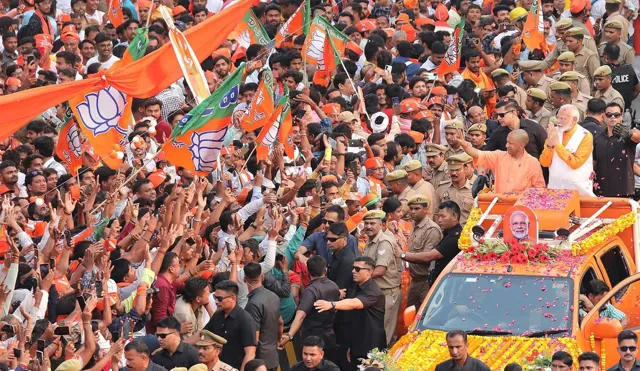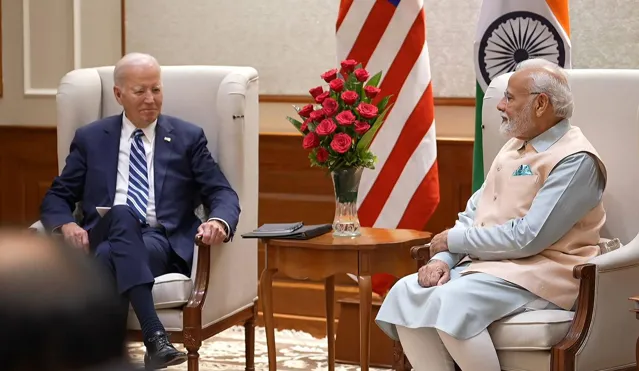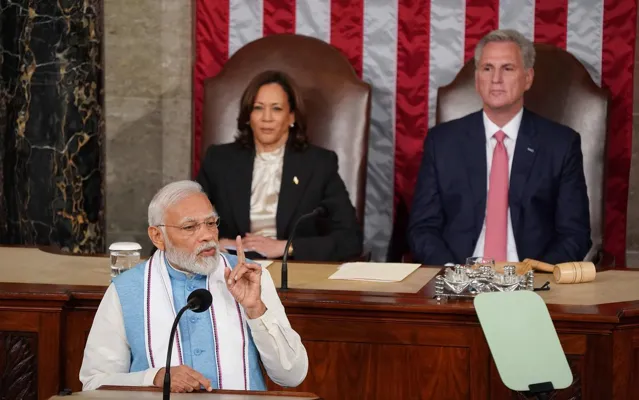【文/ 林民旺】
印度已經開始了全世界規模最大的選舉。印度總理莫迪和他的印度人民黨 (BJP) 似乎已做好了勝利的準備。莫迪在印度能夠長期維持如此高的支持率,背後有多種原因,例如印人黨的宣傳機器將莫迪不斷神話,印度經濟上的突出表現,以及莫迪不斷以印度教民族主義旗幟來吸引普通民眾等等。

當地時間2024年5月13日,印度北方邦瓦拉納西,印度開啟大選第四階段投票,印度總理莫迪參加競選活動。圖自IC photo
外交同樣為莫迪政府增分不少,除了美歐日澳領導人頻繁存取印度之外,莫迪還多次受邀參加G20峰會。2023年在新德裏成功地舉辦的G20峰會,使印度及其政治領導人在國際舞台的「能見度」得到大大提升。
顯然,這多少要歸功於莫迪政府的外交操盤手——外長蘇傑生。他對莫迪的戰略遠見大加贊賞,也不吝表揚印度的外交政策,即使印度在戰略上站隊美國。這樣的戰略選擇可以使得印度外交活動的空間更大,對中國、俄國和美國的戰略杠桿更多,進而使得印度能夠在各方競爭博弈的夾縫中不斷獲利。

當地時間2023年9月8日,印度G20峰會召開前夕,美國總統拜登與印度總理莫迪在新德裏舉行會晤。圖自IC photo
新德裏的外交策略無疑看上去是非常聰明且成功的。但是,從更高的戰略層面上,新德裏的外交能否算是成功的呢?顯然,答案未必是那麽清晰的。至少,新德裏不僅失去了同中國和俄羅斯的傳統友誼和善意,另一方面卻並沒有收獲來自美國及其龐大盟友陣營的戰略信任,成為了一個孤獨的崛起大國。
在莫迪第一任期內,中印盡管爆發了邊境上的洞朗對峙,但是很快兩國最高領導人就在武漢進行了非正式會晤,實作了兩國關系的翻篇重新開機。然而,在莫迪第二任期初期,中印邊境上爆發加勒萬沖突後,兩國並沒有實作關系的轉圜。
加勒萬沖突的爆發,很明顯是印度方面的錯誤導致的。莫迪在事件發生後很快就承認,「(中國)沒有入侵入我們的邊境,我們的哨所也沒有被占領」。中方的反應很克制,直到10個月之後才公布中方軍官和士兵的傷亡情況。
但中國的善意卻沒有換來印度的同等的克制和回報。3月,有報道稱印度計劃向邊境增派軍隊,這違反了2020年9月中印兩國防長會晤所達成的共識。新德裏以邊境邊界問題作為杠桿,將中印關系維持在可控制的緊張狀態上,以此作為拉近同美國陣營的敲門磚。
在2022年9月上合組織撒馬爾罕峰會、2022年11月峇里島G20峰會,以及2023年8月南非金磚峰會上,莫迪都有機會與習近平舉行正式會晤並修復兩國關系。但是,新德裏卻選擇了另一條道路,這給中國釋放的訊號是——新德裏已經在中美競爭的戰略博弈中下註了美國。
印度與俄羅斯的傳統友誼同樣受到了俄烏沖突的考驗。俄烏沖突爆發後,雖然印度沒有加入譴責俄羅斯的行列,但莫迪卻中止了同普京的年度會晤。購買俄羅斯石油時,印度在議價上更是「落井下石」,極力壓低價格。
印度國防參謀長 阿尼爾·喬漢甚至公開評價道「俄羅斯的地緣政治影響力在未來會下降,盡管它是一個核大國」這多少反映出印度對現狀的評估,也讓俄羅斯意識到,印度事實上押註俄羅斯會在俄烏沖突中「戰敗」。
與2014年印度對克里米亞問題的官方回應相比,印度此次的做法顯然讓俄國人感到失望。在俄羅斯看來,兩國傳統友誼和信任因此受到了嚴重損害。
如此看來,中俄領導人都宣布不參加新德裏的G20峰會,也是順理成章的了。
與此同時,莫迪頻繁受邀出現在了美西方主導的多邊舞台上,印度成為了美國重要的軍事夥伴。但印度和美西方國家並不是鐵板一塊,加拿大指控印情報部門在加刺殺了一名錫克教人士。印度對此指控做出了強勢回應,這遭到了美國和英國等國的批評。美國聲稱自己也挫敗了一場涉嫌在紐約暗殺錫克教男子的陰謀,同時英國和澳洲也對此感到緊張。拜登政府盡管「高高舉起,輕輕放下」,但是在盎格魯撒克遜國家看來,莫迪領導下的印度,本質上也是一個「異類」國家。

當地時間2023年6月22日,印度總理莫迪受邀在美國國會發表演講。圖自IC photo
印度與日本的關系,在安倍晉三執政時期,確實發生了重要提升。但隨著安倍晉三下台,日本領導人已經沒有發展同印度關系的興趣和熱情了。由日本承建的,從印度孟買到艾哈邁巴德的高鐵專案於2017年動工,但目前工程進度面臨全面延期,預計於2026年才能投入營運。而日本與印度為了對抗中國的「一帶一路」倡議而共同提出的「亞非增長走廊」倡議,迄今沒有任何實際進展。
日本極力拉印度加入RCEP以擴充套件自身經濟聯盟並平衡中國的經濟影響力,但是印度卻最終結束了RCEP。而印度對日本企業在印投資激增的幻想也一再落空。 蘇傑生在三月於東京舉行的瑞辛納圓桌會議上表示,「有很多歐美的商務代表團考察印度,但沒有看到那麽多來自日本的代表團。」
莫迪政府顯然沒有註意到美西方對印度崛起的整體性的戰略焦慮,仍在不斷宣揚印度的經濟崛起的成就。印度幼稚的想法基於這樣一種假設——美國及其盟友要遏制中國經濟發展,就會致力於幫助印度崛起。但如果說是美國提供的國際環境促成了中國崛起,那麽美國有什麽理由會再次犯下同樣的「錯誤」呢?
總而言之,過去五年的莫迪外交,以表面上的風光換來了印度在國家戰略上的根本性傷害。中國有句古話,聰明反被聰明誤。莫迪的外交政策,顯示出印度的精明,但是卻可能埋下這個國家戰略悲劇的禍根。
(本文英文版正選於【南華早報】,作者授權觀察者網釋出中文版。)
以下為文章英文版:
As India conducts the world’s biggest election, Prime Minister Narendra Modi and his Bharatiya Janata Party (BJP) appear poised for victory. Modi’s popularity has been attributed to myriad factors, including the BJP’s adept mythologisation of the leader, India’s robust economic trajectory and Modi’s appeal to Hindu nationalism.
The performance of diplomacy is another factor. A flurry of visits from leaders of the United States, European countries, Japan and Australia, coupled with Modi’s attendance of G7 summits, have elevated India’s visibility, notably as the G20 summit host last year. The Modi administration’s diplomatic performance can be largely credited to the acumen of External Affairs Minister S. Jaishankar, who has lavished praise on Modi’s strategic vision and been forthright in defending Indian policies, even while strategically aligning with the US-led bloc.
This tactical alliance has afforded India greater diplomatic agility and leverage amid the complex dynamics of its relationships with China, Russia and even the US, enabling it to capitalise on the competitive fractures among these global powers.
New Delhi’s diplomatic manoeuvres seem shrewd and efficacious but are they really? India’s camaraderie with China and Russia has been progressively strained, while the strategic trust of the US and its allies remains tenuous, with India increasingly being seen as an isolated ascending power.
After the 2017 Doklam stand-off, India and China swiftly restarted diplomatic relations at an informal summit in Wuhan. In stark contrast, relations after the 2020 Galwan Valley clash have yet to see a similar thaw.
The events leading to the Galwan Valley clash were predominantly a result of Indian missteps. As Modi said soon after the incident, China has not 「intruded into our border, nor has any post been taken over by them」. China’s reaction was restrained, only revealing its casualty numbers many months later.
But China’s goodwill has not been reciprocated. In March, it was reported that India planned to move more troops to the border in contravention of the consensus reached in September 2020. India has since leveraged the border dispute to foster a controlled tension with China, using this as a door knocker to gravitate closer to the US-led alliance. There were many opportunities for Modi and Chinese President Xi Jinping to repair relations face to face,including at the September 2022 Shanghai Cooperation
The long-standing India-Russia relationship has also been tested by the Ukraine conflict. Despite India’s refusal to condemn Russia, Modi has suspended his annual summit with Russian President Vladimir Putin and adopted a stern bargaining stance when buying Russian oil.
Last October, India’s Chief of Defence Staff Anil Chauhan said: 「The geopolitical importance of Russia will go down in times to come. It is in spite of being a nuclear power.」 This reflects India’s risk assessment and suggests it is wagering on Russia’s defeat in Ukraine.
Compared to India’s official response to Russia’s annexation of Crimea in 2014, its approach this time has clearly disappointed Russia. In Russia’s view, the traditional friendship and trust between the two countries has been severely damaged.
Unsurprisingly, Russia’s interactions with India have largely ceased. Neither Putin nor Xi attended the G20 summit in New Delhi last year.
In the meantime, Modi has been invited to several forums dominated by the US and its allies, and has become an important defence partner of the US.
But India’s harsh response to Canada’s allegation of an assassination plot against a Sikh activist has been criticised by the US and Britain, among others. The US says it has foiled an alleged plot to assassinate a Sikh man in New York, and tensions have been felt in Britain and Australia. If nothing else, India is showing itself up as an ill fit for the Western alliance.
With Japan, relations with India saw a marked improvement during Shinzo Abe’s tenure. But with his departure, Japanese enthusiasm for deepening ties with India has waned. The Japan-backed high-speed rail project to connect Mumbai to Ahmedabad, launched in 2017, has faced delays and is now expected to be operational by 2026. The Asia-Africa Growth Corridor, a Japan-India collaboration announced in 2017 with hopes of rivalling China’s Belt and Road Initiative, has gone nowhere.
Japan had also vigorously encouraged India’s participation in the Regional Comprehensive Economic Partnership (RCEP) as a means of diversifying economic alliances and counterbalancing China’s influence – only for India to dramatically back out at the last minute.
The hoped-for surge in Japanese business investment in India has also failed to materialise. At the Raisina Roundtable in Tokyo in March, Jaishankar said the growing Indian market has attracted many business delegations from Europe and the US 「but I don’t see that many from Japan」.
The Modi administration, it seems, is overlooking any strategic anxieties that Japanese – and indeed, US and European – business communities may have over India’s rise. This may stem from an assumption that the West, intent on curbing China’s rise, will support India’s progress instead. But given that China’s rise was made possible by conditions in the international environment provided by the US, what are the chances Washington would make the same 「mistake」 with India?
Over the past few years, Modi’s diplomatic endeavours have prioritised quick gains over longer-term strategic advantages. India must beware of becoming a victim of its own cleverness. Modi’s diplomacy shows India’s strategic cunning – but also risks the making of a strategic misfortune for the country.












